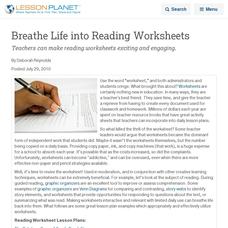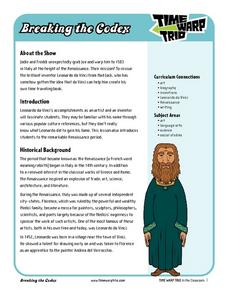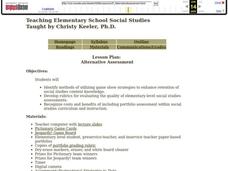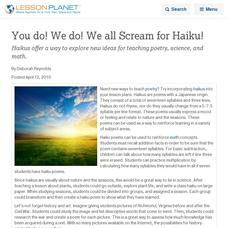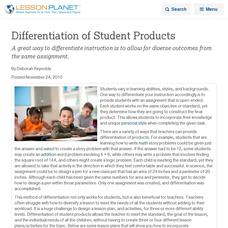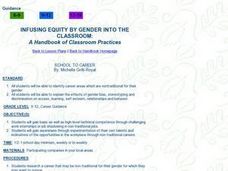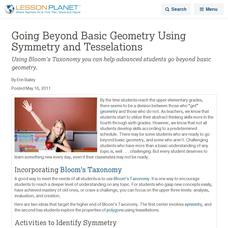Curated OER
The Concept of Wa I
Twelfth graders compare how disputes are resolved in Japan and the United States. They read the case, state the facts of the case, and identify the issues involved. They determine that preserving harmonious relationships is more...
Curated OER
Breathe Life into Reading Worksheets
Teachers can make reading worksheets exciting and engaging.
Curated OER
Celebrating Women: Toni Morrison
Students research Toni Morrison's life, work as a writer, and major contributions to the field of literature; students choose one of her novels to read, & perform a scene from it; each group member writes an autobiographical essay...
Curated OER
Philanthropic Movements in the United States to 1900: 1765 to the Declaration of Independence
Middle schoolers watch and discuss the Johnny Tremain video. They discuss the actions of citizens during the American Revolution and describe these actions as patriotic and/or philanthropic.
Curated OER
Breaking the Codex
Young scholars work with an online multimedia show to study the life of Leonardo da Vinci in Renaissance Italy. They explore different writing systems and create an advertisement for one of Leonardo da Vinci's inventions.
Curated OER
Alternative Assessment
Students identify methods of utilizing game show strategies to enhance retention of social studies content knowledge. They develop rubrics for evaluating the quality of elementary-level social studies assessments. They discuss the...
Curated OER
You do! We do! We all Scream for Haiku!
Haikus offer a way to explore new ideas for teaching poetry, science, and math.
Curated OER
Differentiation of Student Products
A great way to differentiate instruction is to allow for diverse outcomes from the same assignment.
Curated OER
Rudyard Kipling's "Rikki-Tikki-Tavi": Mixing Fact and Fiction
"Rikki-Tikki-Tavi," from The Jungle Book, offers young readers a chance to examine how Rudyard Kipling uses setting and personification to bring to life the brave mongoose who battles cobras to protect his family. Class members...
Curated OER
Everyone Has a Culture -- Everyone is Different
Students are shown various statements and respond to each as a class. They discuss the differences between different groups of people and why they behave differently as well. After completing a worksheet, they discover aspects of their...
Curated OER
Gender Equity in the Classroom and the Workplace
Students research careers non-traditional to their genders. They job shadow at cooperating businesses and investigate gender bias, stereotyping, and discrimination.
Curated OER
Corn Cob Toys
Students make toys from corn cobs. They study the many uses for corn, both historically and today. They write a description of the toy/object he or she has made and provide instructions for making it. They write and perform plays,...
Peace Corps
Features of Culture
Young scholars enumerate features of their own culture and evaluate how those features have influenced their lives. They explain that many differences are related to culture-beliefs and ways of living that are handed down from one...
Curated OER
America in the 1950's
In this America in the 1950's worksheet, students read about housing, education, entertainment, and the Cold War in the 1950s. Students then answer 5 questions about this time.
Curated OER
Using Optical Illusion Brain Teasers Add a Twist to Math and Science
Optical illusion activities can provide a motivating way for students to explore math and science concepts.
Curated OER
Field Trips Can Inspire Students to Write Creatively
Fieldtrips can lead to a variety of writing experiences for students.
Curated OER
Science Center Ideas for Students Who Finish Work Early
A science center can be a great way to extend the learning of students who finish their work early.
Curated OER
Going Beyond Basic Geometry Using Symmetry and Tesselations
Using Bloom's Taxonomy you can help advanced students go beyond basic geometry.
Curated OER
The Strength of the Muscular System
Seventh graders investigate the strength of the muscular system. They explore voluntary and involuntary muscle movement and discuss the types of muscles: cardiac or heart, skeletal, and smooth. They visit stations to answer questions...
Curated OER
Ethics and Philanthropy The Act of Sharing and Giving
Students define ethics, and identify ways that they have practiced philanthropy in their own family. They listen to a book, write an essay, and identify a role model for philanthropy.
Curated OER
Regional Renaissances
Young scholars investigate the differences between the Renaissance and the Northern Renaissance through group interaction and discussion. They write an essay after research.
Curated OER
Your Song
Pupils create instruments to demonstrate their understanding of how the science of vibrations is used to create sounds.
Curated OER
Jefferson vs. Franklin: Renaissance Men
Learners list a variety of interests and achievements of Franklin and Jefferson. They take a position that one or the other's interests and achievements were more wide-ranging or that they were equivalent. They write out their findings.
Curated OER
Who Is Eating Whom?
Students discuss the food chain and identify if various organisms are producers or consumers. They draw ten types of organisms and construct a food web of these organisms, labelling each as a producer or consumer.



